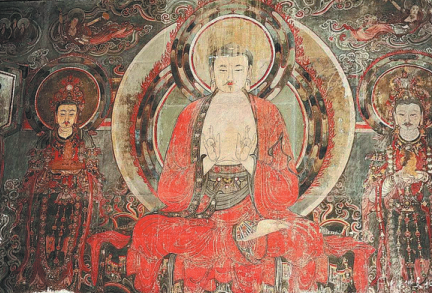Buddhist temple offers colorful cultural palette

The colored murals at Chongfu Temple are said to have been created in the Jin Dynasty (1115-1234). [Photo by Peng Ke'er for China Daily]
Located near the Great Wall of China, an ancient border between the Han people and the northern nomads, the city of Shuozhou in Shanxi province was at the forefront of exchanges between various ethnic cultures for millennia.
A silent witness to the exchanges is the Chongfu Buddhist Temple at the center of the city. Historical records show that Chongfu was first built in 665 in the early Tang Dynasty (618-907).
Major renovations were launched during the Liao (916-1125) and Jin (1115-1234) dynasties. The main structures of the temple, including the Grand Hall of Amitabha Buddha and the Hall of Avalokitesvara Bodhisattva, feature remains of this.
Both Liao and Jin were regimes established by the northern ethnic people of Qidan and Nyuzhen, respectively. So the preserved structures, murals, statues, sculptures, inscriptions and other relics can help researchers and tourists understand what the cultures, religions, architecture and arts of ancient ethnic people were like.
Standing at the center of the temple, covering 23,400 square meters of land, which is said to be the largest Jin building in Shanxi, is the Main Hall of Amitabha Buddha.
When showing this hall to tourists, Zang Xiaochun, a tour guide, explained the cultural characteristics of the hall and temple.
"Since the Northern Wei Dynasty (386-534), Shuozhou had been at the center of ethnic cultural exchanges," Zang said. "When the nomads established their regimes in northern China, including Northern Wei, Jin and Liao, they showed a strong willingness to integrate with the local culture."
The tour guide said many of the ethnic people became followers of Buddhism, which had been popular among the Han people for centuries.
"Like the Han people, the ethnic people of Liao and Jin had a great enthusiasm in building Buddhist temples.
"The temples they built were generally similar with those built by the Han people. But there are still details to show the cultural traits of the nomads," Zang said.
She pointed to two color-glazed guardian statues on the rooftop of the hall, saying that they are Jin Dynasty remains.
"In Han culture, rooftop figures are usually auspicious animals,"Zang said. "If there are any human figures, they are small in size."
But the figures are larger and show great strength and freedom in expression, Zang said. "That is because the nomads more respected strength and freedom in their own culture."
In the Hall of Avalokitesvara Bodhisattva, there is another interesting aspect showing a cultural evolution in Buddhist arts.
She pointed to the Avalokitesvara Bodhisattva statue, reminding people of its shape as a woman but with a bearded face.
"Avalokitesvara, the bodhisattva of mercy, was originally a man in ancient Buddhism," Zang said. "It was later transferred to a woman by Han believers as they believed women are more merciful than men."
So this statue, also created in the Jin Dynasty, shows it was in the middle of this evolution, the tour guide said.
Pe Ke'er contributed to this story.



